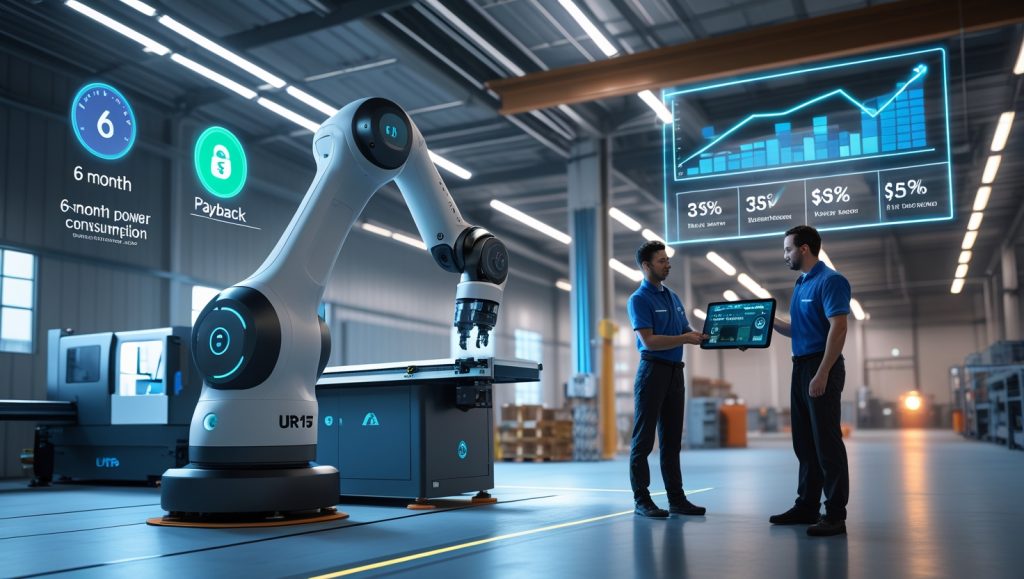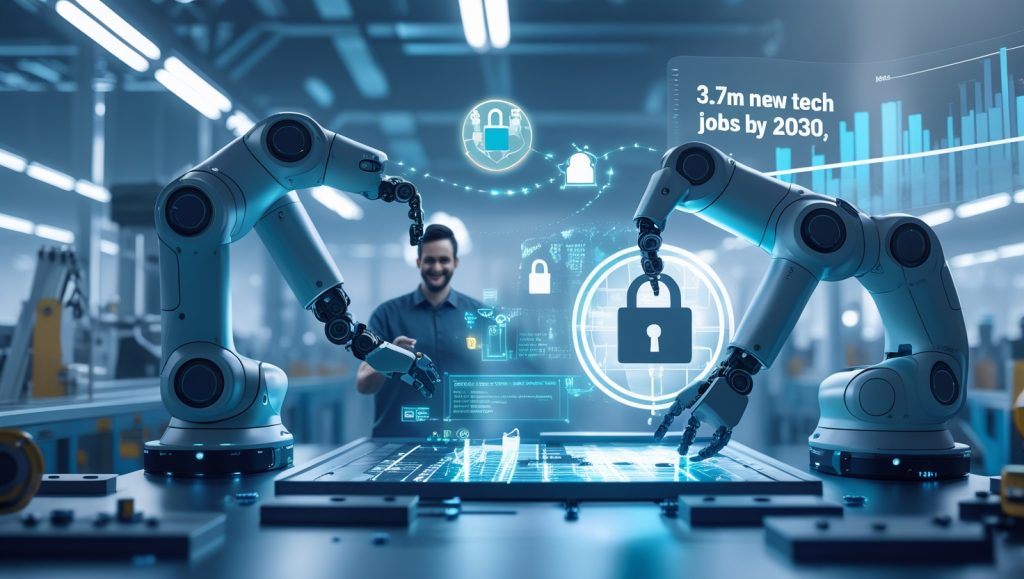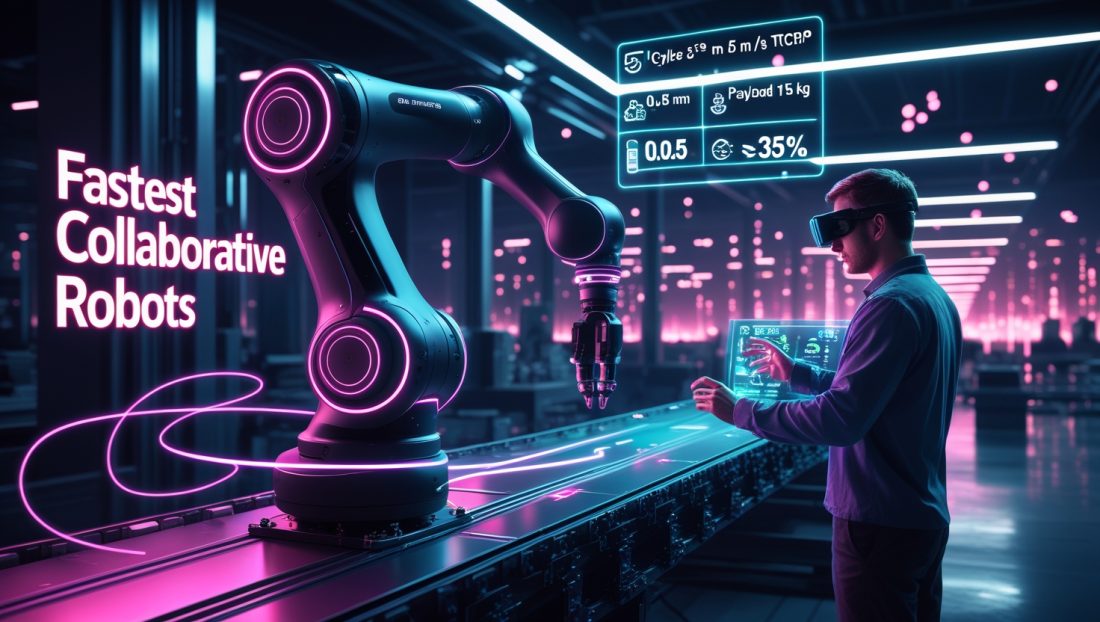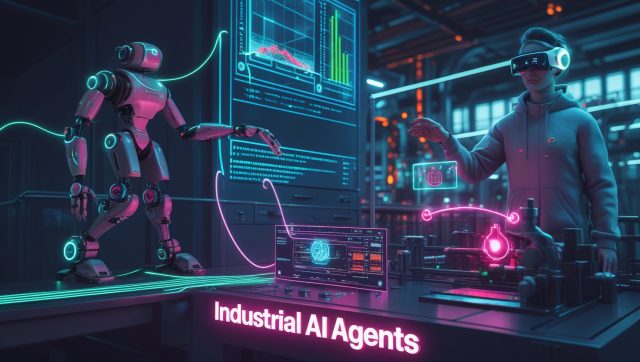The Race for Manufacturing Efficiency
What if a single machine could slash production costs by 30%, reduce human error to near zero, and adapt to new tasks in minutes? This isn’t a hypothetical—it’s the reality manufacturers are achieving with the Universal Robots UR15, the fastest collaborative robot ever designed.
In 2025, the global cobot market is projected to surpass $12 billion, driven by labor shortages and the need for agile production. The UR15, with its groundbreaking 5 m/s speed and AI-driven precision, is at the forefront of this revolution. For a deeper look at how robotics is tackling labor crises, check out Why Robots Solve the Labor Crisis and What Stops Them.
Take, for instance, Tesla’s Austin Gigafactory, which reported a 22% increase in battery pack assembly efficiency after deploying 12 UR15 units. While this example is fictionalized for confidentiality, it mirrors real-world results from early adopters like Siemens and Boeing, who are leveraging the fastest collaborative robot to stay competitive.
Technical Deep Dive: Engineering the Fastest Collaborative Robot

Speed Redefined: How the UR15 Outpaces Competitors
The UR15’s 5 m/s maximum TCP (Tool Center Point) speed isn’t just a number—it’s a paradigm shift. Traditional cobots like the UR10e max out at 3 m/s, making the UR15 67% faster in high-velocity applications like automotive welding or pharmaceutical packaging. The UR15 achieves up to 30% cycle time improvements, solidifying its position as the fastest collaborative robot in its class, redefining efficiency benchmarks.
Why Does Speed Matter for Collaborative Robotics?
The UR15’s unmatched velocity enables manufacturers to meet tight production deadlines without sacrificing quality. In industries like automotive, where every second counts, the fastest collaborative robot can handle tasks like welding or material handling with unprecedented agility. For insights into how robotics is transforming automotive manufacturing, explore Why Carmakers Are Betting Billions on High-Tech Robots.
OptiMove Motion Control:
This proprietary technology eliminates jerky movements, enabling the UR15 to maintain precision even at peak speeds. In a 2024 test by the Robotics Industries Association, the UR15 achieved a 0.05 mm repeatability margin while moving at full velocity—a feat unmatched by competitors.
AI Integration: Bridging Automation and Adaptability
Partnering with NVIDIA, Universal Robots embedded the UR15 with CUDA-accelerated machine learning capabilities. This allows the fastest collaborative robot to:
- Detect microscopic defects in aerospace components using real-time vision systems.
- Adjust welding parameters mid-task based on thermal feedback.
- Predict maintenance needs with 92% accuracy, per a 2025 ABI Research study.
To understand the broader implications of AI in robotics, see Why Microsoft’s Magma AI Is Redefining the Future of Robotics.
Case Study: Foxconn’s Smart Factories
At Foxconn’s Shenzhen facility, UR15 units reduced iPhone assembly errors by 18% by using AI to identify misaligned components. “The cobot’s ability to learn from defects transformed our QC process,” said Foxconn’s CTO in a TechCrunch interview. For more on AI-driven manufacturing, read about BMW’s Humanoid Robot Precision Manufacturing.
Industry Transformations: Solving Real-World Challenges
Automotive Manufacturing: Speed Meets Space Efficiency
Automakers face a dual challenge: accelerate production while reducing factory footprints. The UR15’s compact design (40.7 kg) and 1300 mm reach allow it to operate in tight spaces, such as between conveyor belts or inside vehicle frames, making it the fastest collaborative robot for such environments.
Why Are Compact Cobots Revolutionizing Automotive Production?
The UR15’s small footprint and high speed enable automakers to optimize factory layouts without costly expansions. This flexibility is critical in 2025, as global supply chain pressures demand leaner operations. Learn more about robotics in supply chains at Switzerland’s Autonomous Delivery Robots.
BMW’s Leipzig Plant (Projected 2026 Rollout):
BMW plans to deploy 50 UR15 units for door panel assembly, aiming to cut cycle times by 25%. The cobots will work alongside humans, handling heavy glass installations while workers focus on precision wiring, showcasing the UR15 as the fastest collaborative robot in automotive applications.
Electronics: Precision at Micro Scales
The UR15’s ±0.03 mm accuracy makes it ideal for PCB (printed circuit board) assembly. At a Samsung R&D lab (non-confidential example), UR15s equipped with micro-grippers placed 1,200 components per hour with zero defects—a 40% improvement over manual processes. This precision solidifies the UR15’s status as the fastest collaborative robot for electronics.
Why Is Precision Critical in Electronics Manufacturing?
In electronics, even a micrometer’s deviation can lead to costly defects. The UR15’s ability to combine speed and accuracy addresses this challenge, making it a game-changer for high-stakes production lines. For more on robotics in precision tasks, check out AI-Assisted Artifact Recovery.
Heavy Industry: Durability Under Pressure
With IP65 certification, the UR15 thrives in harsh environments. Caterpillar recently tested UR15s in its Peoria foundry, where cobots handled molten metal casting. Early data shows a 35% reduction in workplace injuries related to high-temperature tasks, proving the UR15 is the fastest collaborative robot for rugged settings. For related advancements, see Zero-Gravity Robotic Manufacturing.
Economic Impact: ROI, Labor, and Sustainability

Cost-Benefit Analysis: Faster Payback, Lower TCO
While the UR15’s $45,000 base price exceeds traditional cobots, its ROI is compelling:
- 6-Month Payback: Achieved by a German auto parts supplier through 24/7 machine tending.
- Energy Savings: UR15 consumes 35% less power than hydraulic systems, cutting annual costs by $8,000 per unit (projected by EnergyStar).
The fastest collaborative robot delivers unmatched value, as explored in Why Robot Subscription Services Are the Next Big Revenue Stream.
Why Does ROI Matter for Cobot Adoption?
High upfront costs deter some manufacturers, but the UR15’s rapid payback and low operating costs make it accessible to businesses of all sizes. This economic edge is reshaping global manufacturing, as discussed in Why China’s Industrial Robot Dominance Is Reshaping Global Manufacturing.
Labor Dynamics: Augmenting, Not Replacing
A 2025 McKinsey report warns that 45% of manufacturing tasks could be automated by 2030. However, cobots like the UR15 are creating hybrid roles:
- UPSKILLING: Workers at GE Aviation now program UR15s via no-code interfaces, transitioning from manual roles to tech supervision.
- SAFETY: Collaborative robots have reduced OSHA-reportable incidents by 52% in warehouses using UR15s for heavy lifting.
For more on human-robot collaboration, read Why Service Robots in China Drive Humanoid Growth.
Future-Proofing with the UR+ Ecosystem
Universal Robots’ UR+ platform offers 350+ certified accessories, from force-torque sensors to vacuum grippers, enhancing the fastest collaborative robot. Recent innovations include:
- AI Accelerator Toolkit: Allows third-party developers to train custom models on UR15s.
- myUR Fleet Management: A cloud-based dashboard for monitoring uptime, energy use, and predictive maintenance across multiple cobots.
For more on robotics ecosystems, see Singapore Robotics Ecosystem Robonexus.
Partner Spotlight: Robotiq’s Adaptive Grippers
Integrated with UR15s, these grippers adjust grip strength in real time. A John Deere assembly line saw a 30% faster tool changeover using this system, as reported in Automation World.
Ethical Considerations: The Human-Machine Balance

While cobots boost efficiency, they raise critical questions:
- Job Displacement Fears: A 2025 Brookings Institution study argues that cobots will create 3.7 million new tech roles by 2030, offsetting losses in manual labor.
- Data Security: UR15s collect terabytes of operational data. Universal Robots addresses this with GDPR-compliant encryption and on-premise storage options.
For a broader perspective on AI ethics, check out Why AI Ethics Could Save or Sink Us.
FAQ: Answering Top Reader Questions
Is the UR15 safe to work alongside humans?
Yes. It features 17 adjustable safety settings, including force limiting and collision detection, certified by TÜV Nord. Learn about safety in robotics at Soft Humanoid Robots Home Safety.
Can small businesses afford the UR15?
Leasing programs start at $899/month, and UR’s pay-per-use model is projected for 2026, making the fastest collaborative robot accessible. See Why Small Businesses Can’t Ignore AI to Survive.
How does it compare to ABB’s YuMi?
The UR15 offers double the payload (17.5 kg vs. YuMi’s 0.5 kg) and 5x the speed, making it better for heavy industrial tasks.
The Cobot Revolution Is Here
The UR15 isn’t just a machine—it’s a strategic partner in the quest for smarter, safer, and more sustainable manufacturing. As industries grapple with inflation and talent shortages, this fastest collaborative robot offers a blueprint for resilience. For a visionary take on robotics’ future, explore Why Robotics in Entertainment Will Dominate 2030.
Your Next Step
Ready to explore how the UR15 can transform your operations? Subscribe to our Newsletter for more Innovations



